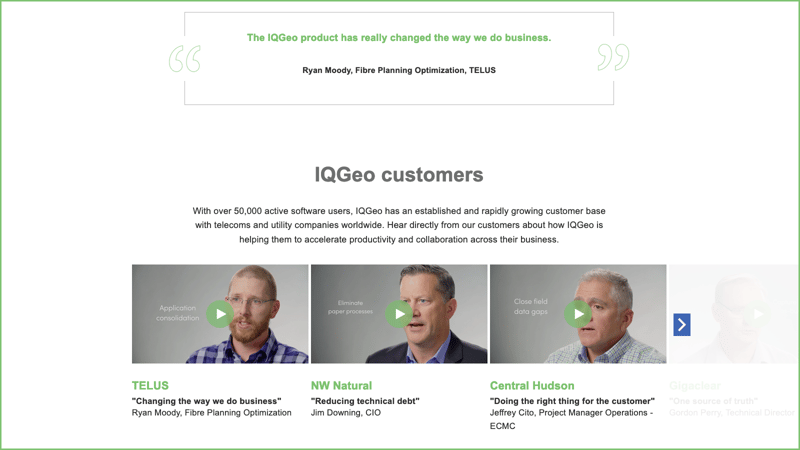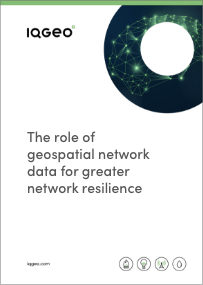Written panel series #4
In this series we will be asking our panel of experts across the geospatial, telecom and utility industries questions about the key issues impacting our world today. Given the evolving future challenges that telecom and utility network operators face, we asked participants to share their insights on what should be the number one technology priority in 2023 to help prepare for the future.
“What do you think should be the number one technology priority for telecom and electric utility operators in 2023?”

"Based on recent trends and current market scenarios, the number one technology priority of telecom operators in 2023 would be 5G deployment leading to network optimization.
The deployment of 5G will provide faster, more reliable and lower latency connectivity, enabling a wide range of new use cases and applications such as connected cars, IoT, AR/VR, and more. Additionally, network optimization will help improve overall network efficiency and performance, delivering better customer experience. By being an early adopter of 5G technology, telecom operators can gain competitive advantage and differentiate themselves from their rivals, as well as enabling the launch of new services and applications such as 5G-powered gaming, virtual reality, and telemedicine.
Investing in 5G technology is not only essential for telecom operators to remain competitive, but it is also a critical step in supporting the wider goal of building a more connected and digital society. However, as 5G may be the number one technology priority for growth, the threats of managing network security and protecting customer data will continue to be a major concern as the industry becomes more digitized and the threat of cyber attacks increases.
Modernizing the electric grid to support the integration of renewable energy sources and reducing greenhouse gas emissions should be the main concern for electric utility operators to meet changing demand. However, you cannot measure what you don’t track, and I would argue that investing in the integration of geospatial data into digital twins is the priority.
Geospatial data can be used to optimize the flow of electricity to meet changing demand in several ways:
● Grid mapping: Geospatial data can be used to create detailed maps of grid assets, which can be used to identify bottlenecks and weak points in the grid and help optimize the flow of electricity.
● Load forecasting: Geospatial data can be used to predict changes in electricity demand based on factors such as weather, population density, and economic activity.
● Renewable energy integration: Geospatial data can be used to identify the most suitable locations for renewable energy sources such as wind turbines and solar panels.
● Outage management: Geospatial data can be used to track and respond to power outages in real-time, prioritize repair efforts and restore power quickly, improving grid reliability and reducing the impact of outages on customers.
Overall, the continued development of digital twins can provide the intelligence necessary to optimize, monitor, predict, and simulate the electrical grid and help utility operators better understand infrastructure interdependencies and make better decisions."
More insights from Luca Budello on the second installment of Network IQ written panel series - The importance of geospatial data for net zero carbon emission priorities.
 “Telecom and utility network operators are faced with many different priorities and opportunities in 2023 that are more exciting than this recommendation, but I believe that their top priority should be the removal of Technical Debt. Tech Debt is an enormous anchor on any organization, and telecom and utility companies are some of the biggest sufferers for a variety of reasons.
“Telecom and utility network operators are faced with many different priorities and opportunities in 2023 that are more exciting than this recommendation, but I believe that their top priority should be the removal of Technical Debt. Tech Debt is an enormous anchor on any organization, and telecom and utility companies are some of the biggest sufferers for a variety of reasons.
Telecom companies are in a constant state of competition which drives change in their organization’s IT environments. There is also a relatively high turnover in staff causing new ideas to proliferate sometimes unchecked before the last one was implemented. By contrast, utility companies are providing critical infrastructure and, as a result, the “if it isn’t broke don’t fix it” attitude has prevailed, leading to legacy architectures and reliance on software long past its sell-by date.
The good news is there are proven technology platforms that can now consolidate and remove the Tech Debt accumulated from legacy and siloed technology. For example, Network Digital Twins enable the digitization of different workflows into a common platform. Modern workflow solutions, such as ServiceNow, can digitize many other workflows that do not require a physical network model. Cloud architecture is powering a new level of integration across enterprises, eliminating silos. Telecom and utility network operators should prioritize the elimination of their Tech Debt in 2023 to enable innovation in the future.”
More insights from Jay Cadman on - The network digital twin secret weapon.
 “Both telecom and electric utility operators are phasing enormous new investments to deal with the challenges of the future. Whether it is rolling out massive new FTTH networks or modernizing and reinforcing existing electricity grids, these investments are very labor intensive. Inflation is increasing pressure on the costs of these projects at a record speed. More than ever, operators need to make the right decisions based on accurate insights in order to optimize the costs of these network construction projects.
“Both telecom and electric utility operators are phasing enormous new investments to deal with the challenges of the future. Whether it is rolling out massive new FTTH networks or modernizing and reinforcing existing electricity grids, these investments are very labor intensive. Inflation is increasing pressure on the costs of these projects at a record speed. More than ever, operators need to make the right decisions based on accurate insights in order to optimize the costs of these network construction projects.
Making the right choices is a bit like predicting the future. But rather than a crystal ball or gut feeling, operators need to be able to model the future of the network in an efficient, accurate and scalable way. This requires two technological components to be put in place.
The first key enabler is the development of a digital representation of their existing and future networks. This representation needs to be accurate and comprehensive so that the cost and performance of a network can be easily measured.
Second comes smart algorithms (Artificial Intelligence) that can run thousands of scenarios and accurately predict the best path towards a future proof network.
Particularly with electric networks, both demand and generation are changing rapidly, requiring a drastic change in the decision making process. Supporting AI-enabled decision making based on an accurate digital representation of the network will be key in making the right decisions and ensure financial investments are optimized.”
More insights from Raf Meersman on the future on fiber network rollouts, utility transitions and the role of automated planning - SCTE Podcast interview with Raf Meersman.
 “My slant on this question, given the work I do with the ODI (Open Data-link Interface) on the value of data and with Kaiasm, is for organizations of all types to think about their data, independent of the technology on which it sits. Boardroom discussions on the subject of data, if they happen at all, are dominated by the risks of sharing information inappropriately – and rightly so, 4% of global turnover is a big number.
“My slant on this question, given the work I do with the ODI (Open Data-link Interface) on the value of data and with Kaiasm, is for organizations of all types to think about their data, independent of the technology on which it sits. Boardroom discussions on the subject of data, if they happen at all, are dominated by the risks of sharing information inappropriately – and rightly so, 4% of global turnover is a big number.
We need to shift the conversation to one about the value that can be created by sharing and using data to better serve customers and outperform the competition. I believe that the most successful organizations will be those that are best at reducing "information rework" efforts within their enterprise and at engaging in a fair exchange of value when using data from the wider ecosystem. ”
More insights from Miranda Sharp on - The importance of digital twins for telecommunications and utilities.
 “Accelerating the digital transformation process will be the major technology priority in 2023.
“Accelerating the digital transformation process will be the major technology priority in 2023.
As we are aware, decarbonization is driving massive growth across the utility industry. As a result, utilities are seeing a significant increase in the volume of work to be performed, whether it be new DER (Distributed Energy Resources) connections, circuit reinforcement, new circuits, etc. The volume of work will continue to increase at an unprecedented rate. Manual and paper processes, as well as disconnected systems, are commonplace today. These limit the volume of work that can be performed and make it extremely difficult to scale.
Leveraging technology utilities can digitize the end-to-end process from initial design, to field walks outs, to construction – resulting in major productivity gains, improved data accuracy and shorter lead times. The next step is to add automation to further accelerate the design and build process.”
More insights from Adrian McNulty on - Telecom industry lessons for electric utility operators.
IQGeo’s Network IQ series shares insights from experts on important telecom and utility industry conversations. You can enjoy the series through short written options and video interviews.
While legacy network management solutions still focuses on their GIS, IQGeo is different. Our Network Manager and application software focuses on your network, and how you can more flexibly and efficiently plan, design, construct and operate your increasingly complex networks. Whether you're building a new fiber and 5G network, modernizing your electricity grid for a renewable future, or delivering safe dependable gas services, IQGeo accelerates time to revenue from a single platform. Find out why our customers choose IQGeo.
Together with IQGeo, telecom and utility network operators build better networks to transform their business. The IQGeo software is setting new standards for productivity and collaboration that increase revenue, decrease operating costs, improve customer satisfaction, and enhance safety.

Visit the customer stories page to see how IQGeo is helping them to reimagine the role of geospatial software.

In this series of Network IQ written panel, we asked industry experts across telecom, utilities and geospatial, how organizations can best use geospatial network data to support disaster response and create network resilience.
Read nowThe industry's most flexible and comprehensive geospatial solution to accelerate network planning, design and time to revenue from a single platform.
See it in action!Copyright © 2025 , IQGeo Group. IQGeo is a registered ® trademark